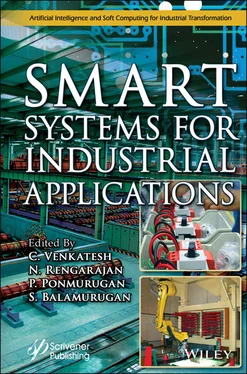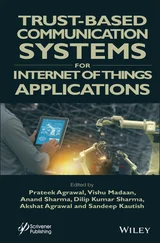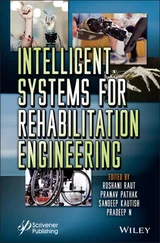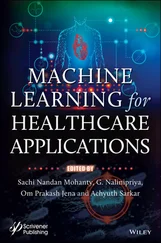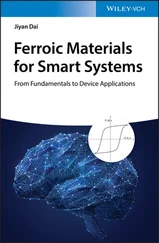Smart Systems for Industrial Applications
Здесь есть возможность читать онлайн «Smart Systems for Industrial Applications» — ознакомительный отрывок электронной книги совершенно бесплатно, а после прочтения отрывка купить полную версию. В некоторых случаях можно слушать аудио, скачать через торрент в формате fb2 и присутствует краткое содержание. Жанр: unrecognised, на английском языке. Описание произведения, (предисловие) а так же отзывы посетителей доступны на портале библиотеки ЛибКат.
- Название:Smart Systems for Industrial Applications
- Автор:
- Жанр:
- Год:неизвестен
- ISBN:нет данных
- Рейтинг книги:3 / 5. Голосов: 1
-
Избранное:Добавить в избранное
- Отзывы:
-
Ваша оценка:
- 60
- 1
- 2
- 3
- 4
- 5
Smart Systems for Industrial Applications: краткое содержание, описание и аннотация
Предлагаем к чтению аннотацию, описание, краткое содержание или предисловие (зависит от того, что написал сам автор книги «Smart Systems for Industrial Applications»). Если вы не нашли необходимую информацию о книге — напишите в комментариях, мы постараемся отыскать её.
The prime objective of this book is to provide an insight into the role and advancements of artificial intelligence in electrical systems and future challenges.
Audience
Smart Systems for Industrial Applications — читать онлайн ознакомительный отрывок
Ниже представлен текст книги, разбитый по страницам. Система сохранения места последней прочитанной страницы, позволяет с удобством читать онлайн бесплатно книгу «Smart Systems for Industrial Applications», без необходимости каждый раз заново искать на чём Вы остановились. Поставьте закладку, и сможете в любой момент перейти на страницу, на которой закончили чтение.
Интервал:
Закладка:
Application of AI in healthcare is utilized for acquiring a huge amount of data, processing the complex inheritance in them, and supporting decisions in case of the limited human intervention [10]. AI’s processing capabilities overcome the limitations mentioned above in healthcare and new methods to help doctors. AI is mainly used in diagnosing the illness compared with prognosis and therapy. Diagnosis is the process of observing and testing the patient, collecting information, analyzing the data, and finally providing a treatment plan. Diagnosis in AI is achieved by feeding patient information to the computing system, which produces diagnosis output.

Figure 1.3 AI-based diagnosis process.
1.2.3 Conversion Protocols
In this section, we discuss two basic protocols used for transforming the process into AI-based [11].
1 (i) Expert system
2 (ii) ANN-based model
The expert system is a technique that is followed for transforming the conventional diagnosis process into an AI-assisted. It outlines the step by step process involved from input to output by framing conditional protocols. The protocols are developed in domain wise by the clinician’s experience and knowledge. Artificial Neural Networks (ANNs) are a parallel processing technique or model which consists of neurons as processing elements, wherein neurons are linked and arranged layer-wise. Layers are also connected. The neurons are assigned with a functional unit and weight value based on the type of application. Weights of the processing could be varied to reach the specified result by applying a backpropagation algorithm. The parallel processing capability of ANN makes it more convenient method for medical applications. ANN-based model is illustrated in Figure 1.4.
Other than a medical diagnosis, ANN is used for analyzing the radiographs in radiology. Gamma, CT, ultrasound, and MRI images are manipulated using ANN. The digitized inputs are given to ANN, processed by inner layers of ANN, and produce appropriate outputs. Orthopedic injuries are successfully identified by trained ANN. In cytology, ANN is used to classify or group the abnormal cells from the specimen cell. It has also been utilized for interpreting EEG and ECG signals. Accuracy of performance on waveform analysis, identification of abnormalities, and data interpretation by ANN is very much useful and reduces the human intervention.
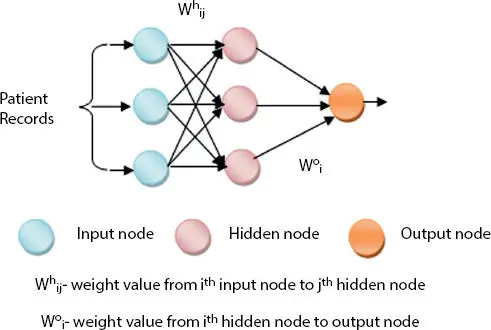
Figure 1.4 ANN-based diagnosis model.
1.2.4 AI in Treatment Assistant
Surgeries are performed by robotic machines, which are controlled by doctors. Robotic surgery is preferred with less invasive techniques, which allow them to perform tasks with better accuracy and control. Mobile ECG monitors and wide usage of smart health watches are utilized for keeping track of and after the surgery. Robotic assistants are employed in elderly care for assisting them in daily routines.
Interfacing the human mind and technology has significant applications in healthcare. Brain-computer interfaces assisted by AI enable patients with neurological diseases to talk, move, and communicate with others. In this scenario, a combination of AI and interfaces decode the neural activities related to the movement of limbs, which further stimulate the indented action.
Immunotherapy is one of the promising cancer treatments. In this therapy, tumors are treated naturally with the human immune system. But a lesser number of patients are responding to these kinds of treatments. Currently, a precise machine learning algorithm is developed to classify and identify the capability of the natural body immune system to treat cancer. AI is also supporting to enable virtual biopsies in the field of radiology, which achieves harnessing image-based algorithms to characterize the patterns and genetic structures of tumors.
AI could reduce the impact on shortages of well-trained healthcare providers by handling over some diagnostic tasks which are allocated to humans. An AI imaging tool take X-rays for tuberculosis symptoms with better accuracy compared to the human. This algorithm is diversified, which considers the environmental factors influencing the disease.
1.2.5 AI in the Monitoring Process
Smartphones have provided numerous tools for patients, which are extremely useful for extracting, transferring, and processing health information. Machine learning algorithms develop mobile applications for analyzing child facial diseases. These algorithms detect unique features such as the child’s jawline, eye, and nose placement to identify the craniofacial abnormalities.
Tracking health information is extended away from hospitals through wearable devices to maintain the fitness of the patients. Wearable devices are made up of internal sensors to measure and save health parameters. AI is used for extracting and analyzing the vast data from the devices and generates useful insights.
1.2.6 Challenges of AI in Healthcare
The potential of AI to increase access to healthcare is tremendous. However, sensible information of the patients is used for processing, which must be protected with restricted access. AI is a system developed by humans; it should have the capability of discriminating features to secure the information. Now, the technology exists everywhere, which causes an impact on human health. It is also required to maintain the balance in using techniques in healthcare.
The essential applications of AI in healthcare are summarized in Table 1.2.
1.3 AI-Driven mHealth Communication System and Services
AI aims to mimic human cognitive functions. It is bringing a paradigm shift to healthcare, powered by the increasing availability of healthcare data and the rapid progress of analytics techniques [12–14]. Recently, AI techniques are applied in mHealth services and systems. There are various health-oriented smartphone applications available. There are around 160,000 of them, which are downloaded about 660 million times [15]. Moreover, blood pressure and heart rhythm are a few smartphone-connected devices that enable remote assessment of health conditions [15]. Identifying atrial fibrillation is one of the hottest topics in the field. The detection of atrial fibrillation was carried by comparing smartwatch data with around normal ECG data of 9,750 patients [16]. A deep learning algorithm combined with smartwatch applications exhibited excellent forecasting of atrial fibrillation with a specificity of 90.2% and a sensitivity of 98%.
Table 1.2 Applications of AI in healthcare.
| Source | Subject matter | Parameter analyzed/considered | Related performance measures |
| [9] | AI in Healthcare | Brain Computer Interfaces (BCI)Next generation radiology toolsExpansion of AI-healthcare networkElectronic Health Record (EHR)Antibiotic ResistancePathology analysisIntelligent medical machinesImmunotherapyRisk predictorHealth monitoring systemDiagnostic toolsClinical decision-making | BCI improves quality of life for patients with ALS, strokes and 5 lakhs people with spinal card injuries with every yearVirtual biopsies characterize the phenotypes and genetic properties of tumorsVoice recognition and dictation help in Clinical documentation.75% EHR use as a tool for right diagnosisAI-based Risk scoring and stratification toolsDL identifies novel connections between seemingly unrelated data sets |
| [10] | Natural language processing | Virtual AssistantMelaFindRobotics Assisted Therapy | Helps the patients with Alzheimer’s diseaseDiagnose tool to analyze irregular moles melanoma skin cancerAssists the patients during stroke recovery |
| [11] | Biological intelligence | Medical data miningANN-based predictionAI-Clinical decision-making | Diagnoses orthopedic trauma from radiographs10% more accurate than conventional decision |
1.3.1 Embedding of Handheld Imaging Platforms With mHealth Devices
Интервал:
Закладка:
Похожие книги на «Smart Systems for Industrial Applications»
Представляем Вашему вниманию похожие книги на «Smart Systems for Industrial Applications» списком для выбора. Мы отобрали схожую по названию и смыслу литературу в надежде предоставить читателям больше вариантов отыскать новые, интересные, ещё непрочитанные произведения.
Обсуждение, отзывы о книге «Smart Systems for Industrial Applications» и просто собственные мнения читателей. Оставьте ваши комментарии, напишите, что Вы думаете о произведении, его смысле или главных героях. Укажите что конкретно понравилось, а что нет, и почему Вы так считаете.
